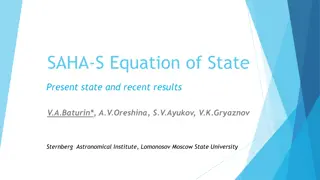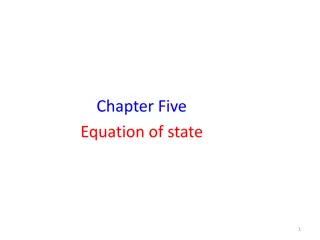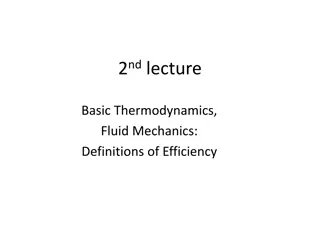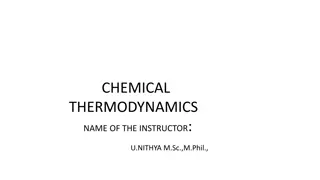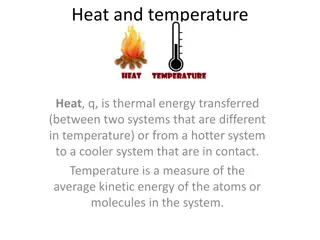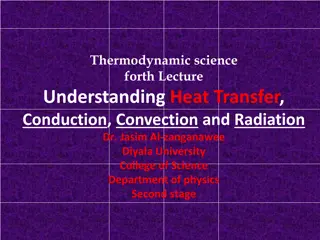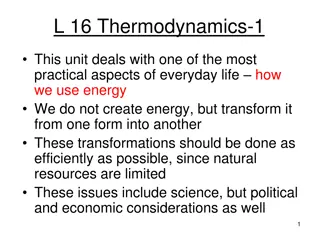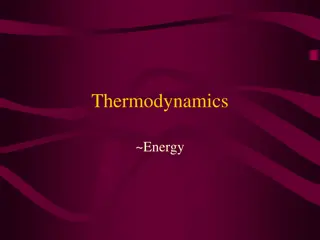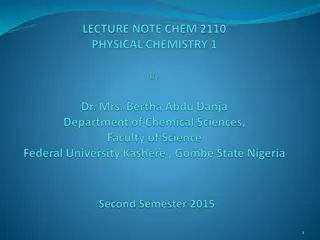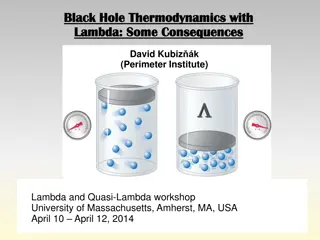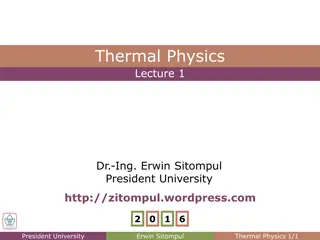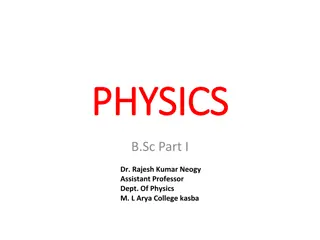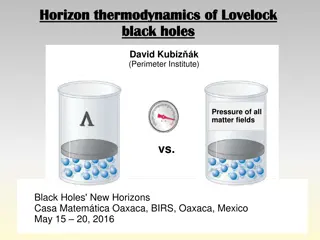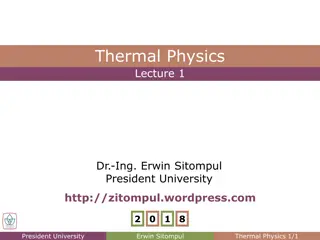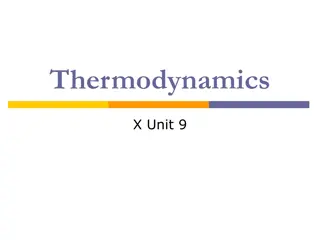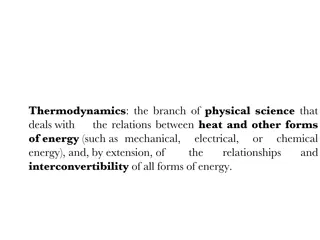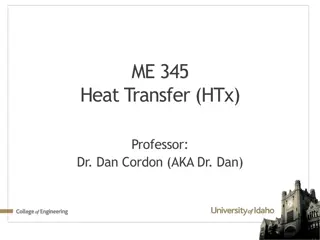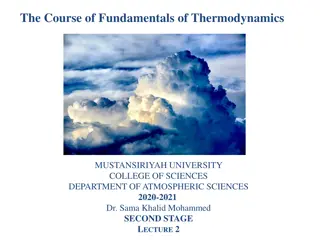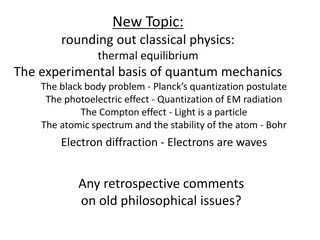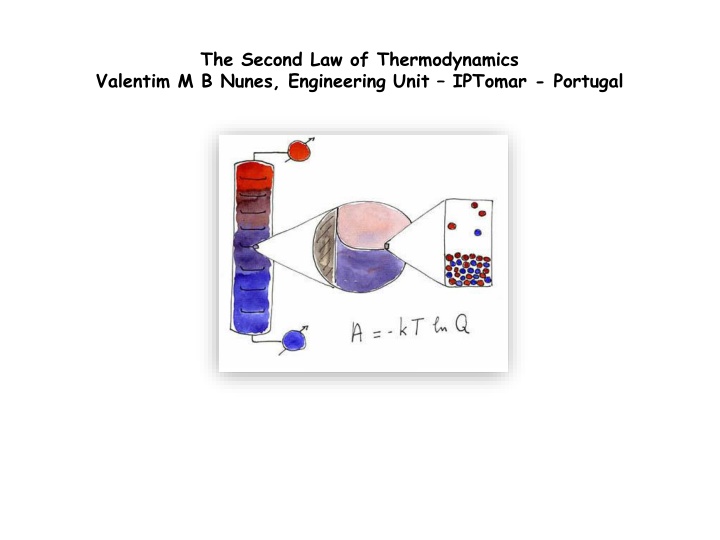
Understanding the Second Law of Thermodynamics
Learn about the significance of the 1st Law and delve into the principles of the 2nd Law of Thermodynamics, exploring spontaneous changes, examples, and the mathematical expressions of entropy.
Download Presentation

Please find below an Image/Link to download the presentation.
The content on the website is provided AS IS for your information and personal use only. It may not be sold, licensed, or shared on other websites without obtaining consent from the author. If you encounter any issues during the download, it is possible that the publisher has removed the file from their server.
You are allowed to download the files provided on this website for personal or commercial use, subject to the condition that they are used lawfully. All files are the property of their respective owners.
The content on the website is provided AS IS for your information and personal use only. It may not be sold, licensed, or shared on other websites without obtaining consent from the author.
E N D
Presentation Transcript
The Second Law of Thermodynamics Valentim M B Nunes, Engineering Unit IPTomar - Portugal
What we learn from the 1stlaw? The 1stLaw shows the equivalence between work and heat and told us that the internal energy of an isolated system (Universe!) is constant. However, the 1stLaw tell us nothing about the spontaneous direction of an event or change! By analogy with mechanical systems, we could think that systems evolves spontaneously to minimum energy But this is not true! U>0 2
What tell us the 2ndLaw There are several asymmetry's in Nature. For instance, hot objects cool down spontaneously, but cold objects don t get hotter spontaneously! A cup of hot coffee does not get hotter and hotter in a cold room! There must be other factors, besides U or H, that determine the spontaneous direction of any change. The Second Law provides a set of principles for determining the direction of spontaneous change and for determining equilibrium state of a system. 3
Spontaneous change; Examples In our everyday life we are observers of many processes that are spontaneous in one direction ant not in the opposite direction. If we stop biting the ball with will immobilize in soil. Nobody ever seen one basket ball spontaneously get higher and higher absorbing energy from the soil! Water freezes spontaneously below 0 C, at p = 1 atm, not the contrary! Heat flow s spontaneously from hot bodies to cold bodies, never the contrary! 4
Expansion of a gas spontaneous p = 0 Not spontaneous For an ideal gas at constant T, U = 0; anyway there were some kind of force that took the gas to expand and occupy uniformly both balloons. 5
Mathematical statement rev W W We saw before, from the 1stLaw, that rev irrev irrev. As a consequence, being U equal in both processes, Q Q irrev rev We now define a new state function, called ENTROPY, S, as dQ Q = rev dS = rev S or T T Q For an irreversible process, and since S is a state function rev S T For an isolated system, Q = 0, so for any process reversible or irreversible we obtain S 0 6
Some statements of the Second Law Spontaneous transformations are those that can be used to produce work. When they are executed reversibly they produce maximum work. In natural or irreversible processes we never obtain maximum work. Any spontaneous transformation produces states of higher entropy in the Universe (an isolated system!) = + 0 Univ S S S syst surr 7
General considerations about entropy The entropy always increase until a maximum in an isolated system. So the entropy is the direction of an event, or the arrow of time ; it could be the physical basis of Time! In real world, we don t expect to find reversible systems. Current processes are irreversible. A) will happens before B); and we will never observe an inversion of time B) before A) (except in movies!) 8
Entropy and disorder Entropy is associated with the measure of the disorder of a system. A gas spreads spontaneously in a room! Chalk break spontaneously and no one expects that small pieces come united again spontaneously! 9
A simple game Probability for one face of the coin = 2 1 1 1 With two coins: = 2 2 2 N 1 With N coins: 2 If N = 100, P = 8x10-31~ 0 The same probability of having 100 molecules of gas in one of the balloons in slide 5! 10
The spread of energy The direction of spontaneous transformations is related with the spread of energy. Why a cup of coffee cannot go to ebullition by transfer of heat from a cold room? The 1st law will not be violated! Let us suppose that heat is transferred from a cold body, at temperature TCto a hot body at temperature TH. Then Q Q = + 0 S T T C H And that is against the 2ndLaw!! In fact the spontaneous process is precisely the opposite. 11
Other statements of the Second Law The second law tell us that in the transformation of heat in work is obligatory to transfer part of the heat to a cold reservoir. That is, Nature demands a contribution when heat is converted in work, but not in the conversion of work in heat! Kelvin statement: It is impossible for any system to operate in a cycle that takes heat from a hot reservoir and converts it completely to work 12
Heat Engines Let s assume that a certain quantity of heat is transferred from a heat reservoir at temperature THand furnished to a heat engine to do work. Part of the heat must be transferred to a cold reservoir, at temperature TC C H C total T T Stotal > 0, as TH > TC. Q Q = + = H S S S C H The heat engine works cyclically and without losses. Global change of entropy cannot be negative. So the minimum amount of heat that must be transferred to de cold sink is: T Q C Q C H T H The work done by the engine when completes a cycle ( U = 0) its equal (in modulus) to the sum of heat imputed and heat rejected: W Q Q W Q U H C + + = + = = 0 = + W Q Q C H 13
Efficiency The thermal efficiency (or thermodynamic) of an heat engine, , its the fraction between the work output to the surroundings, W, and the heat, QH received from the hot source Q Q Q received heat + work output Q W QCis negative and QHis positive! = = = = + 1 C H C Q Q H H H Since the engine works cyclically : Q Q = = + 0 C H S motor T T C H Then the thermal efficiency of the heat engine is: T =1 C T < 1 (<100%) H 14
Carnots Cycle Consider an heat engine that works cyclically and without losses, doing work to the surroundings without increasing the entropy of the exterior. Working fluid is an ideal gas, and all the stages are reversible: A B: Extraction of heat QHtrough one isothermic and reversible expansion at temperature THfrom VAto VB( U = 0) V = = ln B W Q nRT AB H H V A B C: Adiabatic expansion from VBto VC with cooling from THto TC ( C V BC T C W = ) T H C D: isothermic compression at temperature TCfrom VC to VD nRT W = D A: Adiabatic compression from VD to VA ( ) = W C T T V DA V H C ln D CD C V C 15
Thermal efficiency of the Carnots heat engine But, in the adiabatic steps we have VC/VD= VB/VA V ( ) = ln B W nR T T H C V A Then the thermal efficiency comes: V ( ) ln nR T T B H C T T W V = = = H C A Total works is: V Q T ln nRT B H H H V A = + + + W W W W W AB BC CD DA T =1 C V V = ln ln B D W nRT nRT T H C V V H A C 16
Carnots Principles The second law imposes limits on the operation of cyclic devices: A heat engine cannot work through heat exchange with a single source! We can draw two conclusions - Principles of Carnot: 1. The performance of an irreversible heat engine is always lower than that of a reversible heat engine that runs from the same sources (temperatures) 2. Efficiencies from all thermal reversible machines that run between the same two sources are equal. The maximum thermal efficiency of a thermal power station using vapor and running between TH= 750 K and TC= 300 K is 60 %. Real efficiencies are around 38 40%. 17
Examples of S calculations Q Ssist= Isothermic and reversible process: T But, since the system absorbs heat from the exterior or surroundings, then: Ssurr Q = T At constant p H = sist S surr T = + = 0 Univ S S S syst surr 18
Isothermal and reversible expansion of ideal gas = = 0 U Q W At constant T: V f = ln W nRT rev V i V f = ln S nR As a consequence: syst V i V f = In the surroundings: ln S nR surr V i = 0 Univ S 19
Isothermal and irreversible expansion of ideal gas Since the entropy is a state function, then for the gas (system) V f = ln S nR syst V i If we consider now an expansion against an external pressure equal to p=0, then 0 0 , 0 = = = Q U W . As a consequence = 0 S surr and 0 Univ S 2ndLaw! 20
Heating (or cooling) at constant p (or V) T T dQ dH f f T T = = At constant p S Syst T T i i T C f Since dH = CpdT p = S dT T T i T f = ln S C If Cp is T independent, then: syst p T i At constant V we have similar equations. For instance, if CVis T independent then T f = ln S C syst V T i 21
Reversible phase change at constant T and p As an example consider the following transformation: H2O(l,100 C, 1 atm) H2O(g,100 C, 1 atm) The heat necessary for that transformation, at constant p, is the enthalpy of vaporization, Hvap. The entropy change is: H vap = 373 ( 15 . K) S vap T b where Tbis the boiling temperature. Generalizing for any reversible phase transition we have: H = tr S tr T tr 22
Troutons Rule It was found, experimentally, that many liquids have a value for the entropy of vaporization that obeys the Trouton s Rule, that is 1 1 J.mol 85 K . boiling at point S vap Liquid Benzene, C6H6 Carbon Tetrachloride, CCl4 Hexane, C6H12 Water, H2O svap/J.mol-1.K-1 87,2 85,9 85,1 109,1 Structure! 23
Absolute Entropies The absolute entropy of a substance at temperature T can be related to the entropy at T = 0, if we know all the relevant calorimetric properties of the substance, like heat an temperature of phase transitions and heat capacities in the different phases. T T T ( ) ( ) ( ) C s H C l H C g fus 0 b ( ) p fus p vap p = + + + + + 0 ( 1 , bar) 0 K S T S dT dT dT T T T T T fus b T T fus b These lead us to the Third Law of Thermodynamics: The entropy of every pure substance in its crystalline solid state at T = 0 is: ( ) K 0 S = 0 0 This was first expressed as Nernst s Heat Theorem: At T for all isothermal processes in condensed phases. 0, S 0 24
Absolute zero! The 3rdlaw leads to a very important corollary: It is impossible to decrease the temperature of any system to T = 0 in a finite number of steps! In other words, the absolute zero is impossible to achieve! Consider for instance 1 mole of ideal gas that undergoes a spontaneous process that take the system from a temperature Tito a lower temperature Tf T V f f = + ln ln S C R V T V i i But, if Tf= 0, the first term of equation is equal to - , and the second term should be greater than + , which is impossible! 25
How to calculate entropy at low temperatures! For temperatures close to T = 0 a good equation (that can be obtained from statistical mechanics Thermo II) is the Debye cubic equation: Cp= 3 aT Where a is a constant. Substance at 298 K H2O(l) H2O(g) I2(s) I2(g) He(g) Ne(g) S (J.mol-1.K-1) 69.9 189.7 116.7 260.6 126.1 146.2 Cp/T Liq. Sol. Gas ~T3 Tfus Tb 26
Entropy of a substance S solid< S liquid<< S gas 27


